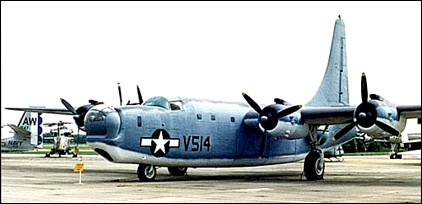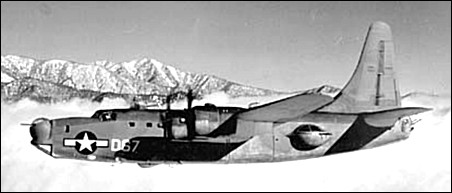|
| The PB4Y-2 was a long-range oversea bomber-reconnaissance development of the PB4Y-1 Liberator. The original contract was placed with Consolidated by the US Navy in May 1943 and work on three prototypes started almost immediately. Four months later, on 20 September, the first prototype flew. It used the same Davis wing and landing gear as the Liberator but was otherwise a new design embodying most of the structural features of its predecessor. The most obvious change was the single fin and rudder. The fuselage forward of the wings was lengthened and armament was rearranged to include a Consolidated nose turret, two Martin dorsal turrets, a Consolidated tail turret and two Erco 'blister'-type waist turrets on the fuselage sides, all with 12.7mm Browning machine-guns. A total of 740 were built. A transport version was also built as the RY-3, of which a small number found their way into US Navy and RAF service.
| MODEL | PB4Y-2 |
| CREW | 11 |
| ENGINE | 4 x 1,350hp Pratt & Whitney R-1830-94 |
| WEIGHTS |
| Take-off weight | 29510 kg | 65059 lb |
| Empty weight | 17018 kg | 37518 lb |
| DIMENSIONS |
| Wingspan | 33.53 m | 110 ft 0 in |
| Length | 22.73 m | 75 ft 7 in |
| Height | 9.17 m | 30 ft 1 in |
| Wing area | 97.36 m2 | 1047.97 sq ft |
| PERFORMANCE |
| Max. speed | 382 km/h | 237 mph |
| Cruise speed | 225 km/h | 140 mph |
| Ceiling | 6309 m | 20700 ft |
| Range | 4508 km | 2801 miles |
| ARMAMENT | 12 x 12.7mm machine-guns |
 | A three-view drawing (948 x 836) |
| Bob Jacobsen, e-mail, 24.09.2009 05:22 I checked out of VB-4 early 1946. 35 men died in a two plane collision practicing fighter evasion south of Eglin AFB. I was scheduled for that flight as instructer,the 36th man. This got national newspaper attention. I would appreciate any newspaper clipping that anyone still has. reply | | Tom Dailey, e-mail, 23.06.2009 00:55 My Uncle Bill (William J. Smatla, AD(j)-1, USN ret. flew as crewchief in many of them. Antisub patrol over NORLANT,knowing that if the fans quit turning, it was all over due to the very cold water off of Greenland.
I just got through donating the Homelite APU that every one of 'em carried, to the Combat Air Museum in Topeka, KS. I lost Bill 2 years ago, and it was his favorite toy. Got to start one up in Graybull, WY- what a rush.
Tom - former RMC USN reply | | Ken Swick, e-mail, 19.06.2009 00:13 The PB4Y2 at the Lone Star Flight Museum in Galveston, Texas is about half-way done. The engines, gear and skin are on. I was there 2 months ago and saw the wiring was being run through the wings to the engines. The vertical stabilizer is an awesome sight as it towers over everything. I can't wait to see this thing fly. reply | | Brian Billington, e-mail, 18.04.2009 04:53 My Dad flew in the first pb4y2 squadron in the south pacific during ww2.VB118. talk about stories. Mining harbors around Korea, and the japanese outer islands.14hr. missions.Bone of the Being one of the first airplanes to land on Iwo Jime, and having Marines pop their head into the bomb-bay doors asking for caned fruit or anything, which they gladly gave them. To mining a harbor and having a shore battery fire at them, the pilot flies behind a small island and the shore gun lobs shells over it ,trying to hit them.Came back after a bombing and strafing run on a ship with 180 bullet holes in the plane reply | |
| | Dave Bosomworth, e-mail, 06.01.2009 19:50 Flew the PG4Y-2G in 1956-1960 a Coast Guard version for Search and Rescue. Had extra fuel tanks in the bomb-bay could stay aloft longer than you wanted too. First and only aircraft I flew that had 360 degree radar. Cranked down radome in the belly after take off. Great visibility for searching big picture windows in the waist compartment where the machine guns had been removed along with seat in the nose for a forward observer. The Coast Guard replaced this a /c with the R5D and later the SC130B reply | | Tom Glass, e-mail, 26.07.2008 21:29 The single vertical stabilizer was for better low level stability which the Navy did often. I toured one at NAS Memphis. VP-9 P2V vet, 1956- 1959. reply | | Tom Glass, e-mail, 26.07.2008 21:28 The single vertical stabilizer was for better low level stability which the Navy did often. I toured one at NAS Memphis. VP-9 P2V vet, 1956- 1959. reply | | Terry Palmer, e-mail, 23.04.2008 19:42 My Dad (Martin Palmer) flew as an aircrew member on these birds in Korea. His Aircraft Commander was Campbell and he has some great stories...1) running out of gas after leaving the active runway after a longggg mission, 2) How much damage can your own .50 cal empties do to your own plane? 3) Returning from Hawaii with more beer than fuel, 4) Candlelight missions with depth charges on truck convoys in valleys, 5)How strong are your cable connections? 6)Classified missions to ____ involving fire hoses...and so much more!
There is a PB4Y2 being fully restored by the Lone Star Aviation Museum at Galveston Tx. Get on their site they have some other great birds also!
Enjoy!
Terry reply |
|
Do you have any comments?
|
| 
COMPANY
PROFILE
All the World's Rotorcraft
|








